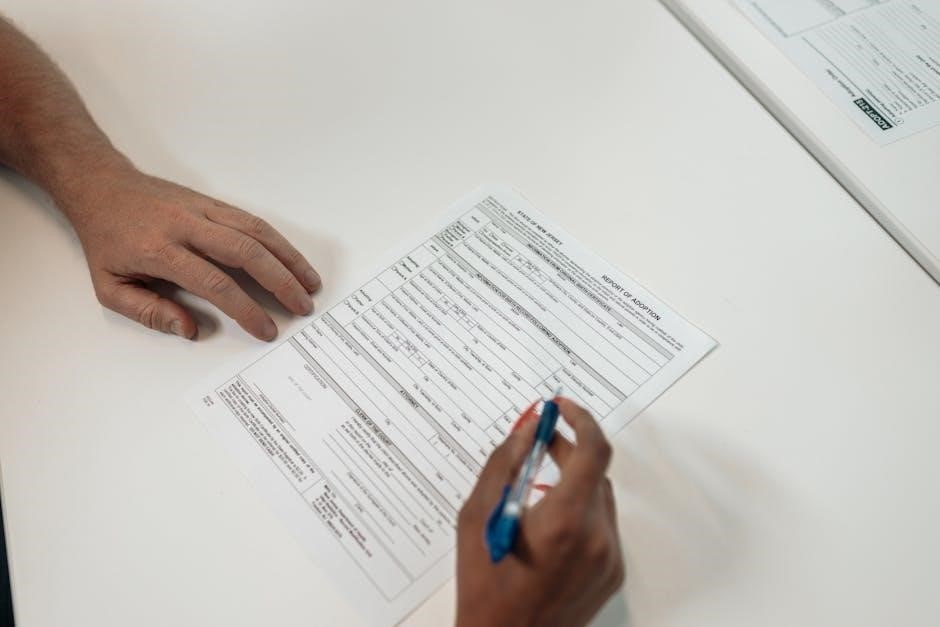Discover how to unlock signed PDF documents securely while maintaining their integrity. Learn methods to remove digital signatures and passwords, enabling editing and modifications legally and safely.
1.1 Understanding the Importance of Unlocking Signed PDFs
Unlocking signed PDFs is crucial for editing or modifying documents while preserving their authenticity. It allows users to bypass restrictions, enabling actions like printing or copying, while ensuring legal compliance and maintaining the document’s integrity for further use.
1.2 Key Considerations Before Unlocking a Signed PDF
Before unlocking a signed PDF, ensure you have the necessary permissions and passwords. Verify the legality of modifying the document, as altering signed PDFs may breach agreements or laws. Additionally, assess the impact on the document’s authenticity and security to avoid unintended consequences.
Method 1: Using Adobe Acrobat to Unlock Signed PDFs
Ensure you have legal permission to unlock the PDF and understand the implications of modifying a signed document. Verify the password requirements and consider the impact on document authenticity and security before proceeding.
2.1 Opening the Signed PDF in Adobe Acrobat Pro
Launch Adobe Acrobat Pro and select “File” > “Open” to choose your signed PDF. Ensure you have the necessary permissions and passwords to proceed with unlocking the document securely.
2.2 Navigating to Document Properties and Security Settings
Right-click the opened PDF and select “Document Properties.” In the Properties window, navigate to the “Security” tab; Here, you can view encryption settings and access the “Security Method” dropdown to manage document permissions and prepare for unlocking.
2.3 Removing the Digital Signature and Security
In Adobe Acrobat Pro, after accessing the Security tab in Document Properties, select “No Security” from the Security Method dropdown. Enter the password if prompted and click OK to remove the digital signature and security settings, allowing the PDF to be edited freely while ensuring document integrity is preserved.

Method 2: Unlocking Signed PDFs Using Online Tools
Upload the signed PDF to platforms like HiPDF, enter the password, and unlock the document instantly. Download the unlocked file for easy editing without needing software installation.
3.1 Uploading the PDF to HiPDF or Similar Platforms
Visit HiPDF’s official website and upload your signed PDF file. The platform offers a user-friendly interface for secure uploading. Once uploaded, follow the prompts to enter the password and initiate the unlocking process. This method is efficient and requires no software installation, making it ideal for quick access to your document.
3.2 Entering the Password and Unlocking the Document
After uploading, enter the PDF’s password in the designated field. Click the “Unlock” button to remove restrictions. The platform will process the file, eliminating editing and printing limitations; Ensure the password is correct to avoid errors. Once unlocked, the document is ready for downloading or further modifications, maintaining its original quality and content integrity.
3.3 Downloading the Unlocked PDF File
Once unlocked, click the “Download” button to save the file. Choose a secure location to store the PDF. Ensure the file name is descriptive for easy access. The downloaded document will be free of restrictions, allowing editing, printing, and sharing. Verify the file’s integrity to confirm successful unlocking and readiness for further use or modifications.

Method 3: Utilizing Third-Party PDF Unlocker Software
Third-party PDF unlocker tools offer efficient solutions to remove signatures and security. These programs are user-friendly, enabling quick removal of restrictions to allow editing and modifications. Many tools support batch processing, making them ideal for multiple files. They are a convenient alternative for users without access to Adobe Acrobat or online platforms.
4.1 Downloading and Installing PDF Unlocker Tools
To begin, download a reputable PDF unlocker tool like PDF-XChange Editor or HiPDF. Visit the official website, select the appropriate version for your OS, and follow the installation wizard. Ensure the software is from a trusted source to avoid security risks. Once installed, launch the tool to start the unlocking process. Many tools offer free trials or versions, allowing users to test features before committing to a purchase.
4.2 Using Software to Remove Restrictions and Signatures
Launch the installed PDF unlocker tool and import the signed PDF. Use the software’s built-in options to detect and remove digital signatures and security restrictions. Enter the password if prompted, then apply changes to unlock the document. Ensure the process maintains document integrity while enabling edits. Always verify the software’s reliability to avoid data compromise.
4.3 Saving the Unlocked PDF for Further Edits
After removing restrictions, save the unlocked PDF by selecting “Save As” from the file menu. Choose a secure location and format, ensuring data integrity. Regularly back up the file to prevent data loss. Use strong passwords for sensitive documents and verify compatibility with editing tools before proceeding with further modifications.

Things to Consider When Unlocking Signed PDFs
Ensure compliance with legal standards, maintain document authenticity, and prioritize security when unlocking signed PDFs to avoid unauthorized modifications and potential legal repercussions;
5.1 Legal Implications of Modifying Signed Documents
Modifying signed PDFs can lead to legal repercussions, as it may invalidate the document’s authenticity. Ensure you have proper authorization to unlock and edit, as unauthorized changes can breach contracts or agreements. Always consult legal counsel to verify compliance with local laws and regulations before proceeding with any modifications.
5.2 Maintaining Document Authenticity After Unlocking
After unlocking a signed PDF, ensure document authenticity by preserving its content integrity. Avoid altering sensitive data, as this can void the original signature’s validity. Reapply digital signatures if necessary and verify the document’s consistency. Use trusted tools to maintain the file’s authenticity, ensuring it remains legally binding and tamper-evident after modifications.
5.3 Best Practices for Securely Handling Unlocked Files
After unlocking, store files securely to prevent unauthorized access. Use encryption for sensitive data and limit sharing. Apply strong passwords and access controls. Regularly back up files to avoid data loss. Ensure all editing tools are reputable to prevent malware. Reapply security settings after modifications to maintain protection and compliance with legal standards.

Advanced Tools for Editing Unlocked PDFs
Explore advanced tools like PDFTK, QPDF, and Preview for enhanced editing of unlocked PDFs. These tools offer command-line options, decryption features, and macOS-native solutions for precise control over your documents.
6.1 Using Preview for macOS Users
Preview, a native macOS application, offers a free and efficient way to unlock and edit PDFs. Open the PDF, enter the password to unlock it, and edit freely. Its intuitive interface allows annotations, signatures, and more without additional software. Ideal for macOS users seeking a straightforward, built-in solution for managing PDF files securely and effortlessly.
6.2 Leveraging PDFTK for Advanced Unlocking and Editing
PDFTK is a powerful command-line tool for advanced PDF manipulation. It allows users to unlock encrypted PDFs, merge files, and apply watermarks. Available for Windows, macOS, and Linux, PDFTK is ideal for automating tasks via scripts. Its robust features make it a favorite among developers and power users needing precise control over PDF operations and security settings.
6.3 Employing QPDF for Command-Line Unlocking
QPDF is a versatile, open-source command-line tool designed for PDF manipulation. It supports decrypting encrypted PDFs and removing restrictions. Using QPDF, users can easily unlock password-protected documents by specifying the password in the command. Its simplicity and flexibility make it a reliable choice for advanced users needing efficient, scriptable solutions for PDF unlocking and processing tasks.
Preventing Unauthorized Access in the Future
Use strong, unique passwords and digital certificates for enhanced security. Regularly update your PDF security software to protect against vulnerabilities and unauthorized access effectively.
7.1 Setting Up Strong Passwords for PDFs
Ensure robust protection by creating complex passwords with a mix of letters, numbers, and symbols. Use unique passwords for each PDF to minimize risks. Avoid common phrases and consider longer passphrases for enhanced security. Update passwords periodically to maintain document safety and prevent unauthorized access. This strengthens your PDFs’ protection against potential breaches effectively.
7.2 Using Digital Certificates for Enhanced Security
Digital certificates add an extra layer of security by encrypting and authenticating PDFs. They verify the signer’s identity, ensuring trust and document authenticity. Unlike passwords, certificates prevent tampering and maintain integrity. Implementing them safeguards sensitive information and ensures compliance with legal standards, making your PDFs more secure and reliable for official use.
7.3 Regularly Updating PDF Security Software
Regularly updating PDF security software ensures protection against vulnerabilities and enhances encryption strength. Updates often include patches for security flaws, improving resilience to hacking. Keeping software current also introduces new features, such as stronger encryption and better access controls, ensuring your PDFs remain secure and compliant with the latest legal and industry standards.

Troubleshooting Common Issues
Resolve password errors by verifying credentials. Repair corrupted files using tools like PDFTK. Address compatibility issues by updating software or using alternative unlockers.
8.1 Resolving Password-Related Errors
If you encounter password-related errors, ensure the credentials are correct. For owner passwords, verify with the document creator. If forgotten, use password recovery tools. Corrupted files may require repair before unlocking. Always ensure software is updated to handle password security effectively and avoid further issues during the unlocking process.
8.2 Fixing Corrupted or Damaged PDF Files
If your PDF is corrupted or damaged, start by identifying the source of the issue. Use PDF repair tools like Adobe Acrobat or online platforms to fix the file. Redownload the PDF if possible, ensuring a stable internet connection. Regularly back up files and avoid force-closing PDF editors to prevent future corruption and ensure smooth unlocking processes.
8.3 Addressing Compatibility Issues with Unlocking Tools
Compatibility issues with unlocking tools can often be resolved by updating software to the latest version or using alternative tools designed for your PDF version. Experiment with cross-platform solutions like online platforms or built-in apps such as Preview for macOS or PDFTK for Windows. Additionally, repairing corrupted PDFs and ensuring proper permissions can mitigate compatibility problems effectively.
Unlocking signed PDFs requires careful consideration of security, legality, and document integrity. Using tools like Adobe Acrobat, online platforms, or specialized software ensures safe and effective removal of restrictions, enabling necessary edits while maintaining authenticity.
9.1 Summary of Effective Methods for Unlocking Signed PDFs
Effective methods include using Adobe Acrobat Pro to remove signatures, online tools like HiPDF for quick unlocks, and third-party software such as PDF Unlocker for advanced features. Each method ensures secure and efficient removal of restrictions while preserving document integrity, allowing users to edit and modify PDFs as needed.
9.2 Final Tips for Working with Secure PDF Documents
Always use strong passwords and digital certificates for enhanced security. Regularly update your PDF software to protect against vulnerabilities. Maintain document authenticity by preserving signatures post-unlocking; Backup files before modifications and ensure compliance with legal standards when editing signed PDFs to avoid unauthorized access and data breaches.
